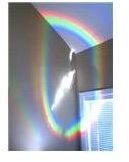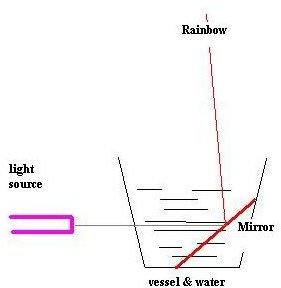Cool Science: Indoor Rainbow Experiment for Kids
Here is an experiment which your stidents will surely love to do. It involves creating their own rainbow (or at least a sort of rainbow) inside your classroom. The icing on the cake is that you do not need any costly equipment or colors to create this magic. Nature already has the ingredients that you require in the form of light. You simply need an arrangement to split the light up into its components. This will form the rainbow.
Requirements
-
A strong flashlight or source of light which produces white light
-
A wide-sized vessel made of glass, filled with clear water
-
A small piece of mirror which fits into the vessel at the bottom
-
A room which has curtains or blinds, so that the room can be turned completely dark (or as dark as possible)
Figure 1: The Set Up
Procedure
Place the glass vessel filled with water on a table and put the mirror inside it so that the mirror is placed at an angle to the vertical side of the vessel. Take a close look at Figure 1 (above) to understand how the arrangement should look. It is a very simple computer generated diagram and the various parts are labeled on the diagram itself.

Now for the magic!
Close all doors and windows, and cover any openings with curtains or whatever you wish so that the room turns as dark as possible. If you are afraid of the dark then keep a friend with you (and study some real heroic tales later on to overcome this fear). Mumble the magic spell a few times (just joking) or say “Here comes my Rainbow.” Switch on the torchlight (flashlight) and focus it on the mirror inside the glass vessel. You should see a rainbow appear on the wall or the ceiling depending on the position of your mirror. Try adjusting the angle if it is not appearing.
Explain The Reason
Now explain to your students what just happened: The appearance of the rainbow is actually due to the splitting of the white light from the flashlight into its seven components. These are known by the acronym VIBGYOR, and stand for violet, indigo, blue, green, yellow, orange and red colors respectively.
Pure white light is a mixture of these colors. When white light is refracted, it splits into its components - thus giving the effect of a rainbow. The same thing happens after rain, when the water droplets that are left suspended in the atmosphere act as glass mirrors to refract the light of the sun.
Let the students take turns angling the mirror and the flashlight to mimic the experiment. If possible, depending on materials, set up multiple stations and divide the class in to groups, so everyone gets a turn. You can also hold a friendly competition and let the class vote on which group can make the prettiest rainbow.
